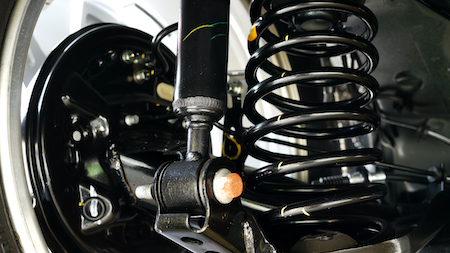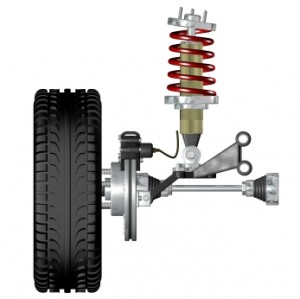We’ve all seen the aftermath of a car out of control. The sides are crushed. The windows are broken. If it rolls, the roof may be caved in.
It’s your car’s suspension system that keeps it safely on the road.
A car can flip for a number of reasons. But if it isn’t well maintained, it increases the chance of problems occurring while driving out on the open road. Have you noticed:
- Bouncing more than usual when you ride on a bumpy road
- More pull in the steering wheel as you drive
- It’s harder to keep control on wet roads
- Traction issues as you move through curves and take turns
All of these are signs you may be experiencing problems with your suspension system.
What is a suspension system?
Your car’s suspension system is a protective layer of shock-absorbing components designed to keep your drive safe and smooth as you move down the road. It includes a variety of parts, including tires, struts, shock absorbers, steering, springs, sway bars, and axles.
The front suspension system is in charge of steering and traction functions, while the rear suspension helps keep your car stable, ensuring it doesn’t hit the ground. The two work together to keep distance between the car’s frame and the road for optimal comfort and control. The passenger cabin is designed for comfort because it’s sitting on top of the suspension connected to the wheels. It’s insulated to keep passengers from feeling every impact as it maneuvers over bumps in the road.
When you talk with a mechanic about your suspension system, in general, it includes:
- Springs, which control the height and load
- Shocks, which absorb and dampen the energy your tires transmit as they contact the road
Your car may also have an anti-sway bar to help shift the movement of your wheels as you turn the steering wheel. It stabilizes the car as you turn the steering wheel to move directions.
Why the suspension system is important
If you were to separate the suspension system from the cabin for a moment, and see the wheels in action as they move down the road, you would see the tires take the brunt of every bump in the road. Small bumps may move the tires vertically. Holes may cause the tires to move and sway. Depending on the size of the imperfection in the road will determine just how much your vehicle’s tires move and sway.
Without a suspension system, you would feel every one of these imperfections every time you hit one. Your drive would be uncomfortable at best.
The suspension system works to absorb the energy transferred through the wheels to help your car’s inside cabin stay comfortable as it rides along imperfect roads. Both the shocks and springs play a vital role in this process. The shocks absorb the energy from impact as you travel down the road, while the springs expand to dissipate the energy to prevent your car from bouncing out of control.
Combined, you get a car that stays safe and remains comfortable no matter where you drive.
You have more control through steering, and can do so with ease. The tires remain connected with the road for a safer and more stable drive. With a properly working suspension system, each part will do its job effectively without putting the other components at risk. Meaning a longer life span for your vehicle.
Signs your shocks and struts need replacing
The words “shocks and struts” are often used reciprocally, but they are two different things. Each wheel has either a shock or a strut, though many vehicles use struts on the front wheels and shocks on the rear. You can consult your owner’s manual for more information on which your vehicle uses. Or look under your car. They are easy to distinguish as long as you know what you’re looking for.
In general, shocks and struts will need replacing every 50,000 to 100,000 miles. This will change depending on your driving habits. If you frequently drive over rough roads, you will be replacing the parts on your suspension system more frequently.
Like other parts of your car, shocks and struts don’t fade all at once. Instead, they deteriorate slowly over time. You’ll start noticing signs long before your safety is put at risk.
There are four main ways your shocks and struts signal it’s time for replacement.
A bumpy ride
If you’ve started noticing your ride is rougher, it could be time to replace the parts on your suspension system. We’ve often heard drivers say, “it feels like I’m driving a truck.” Even the slightest bump in the road will cause you to sway inside your vehicle.
Leaking fluid
Shocks and struts use hydraulic fluid to complete the action. If the seal is broken and fluid leaks on the exterior of the shock or strut, it’s a sign of a problem with the suspension system. If a shock doesn’t have enough hydraulic fluid, it won’t be able to absorb impact while you drive.
Difficulty while driving
Do you notice your vehicle swaying as you take turns? Or nose diving when you hit the brakes? This is a clue the shocks and struts aren’t doing their job efficiently. They aren’t handling the weight distribution as you move through normal driving conditions. And if your car can’t stop as it’s supposed to, it’s never a good sign.
Tire tread
You can also take a look at the tire tread to determine if your suspension system is off. If you see wavy dips, also known as cupping, in the tire tread, it’s a telltale sign of the tires not completely connecting with the road as you drive. Without the shocks and struts performing their jobs, your wheels might not fully connect with the road, leaving uneven wear marks on the tires. Without proper tread, your tires may not provide thorough handling and stopping power when you need it most.
Is it time to get your suspension system checked out?
If you suspect any of these signs are causing a less than stellar drive, it’s time to let a mechanic take a look at the suspension system and ensure it’s in good working condition. It’s what keeps you and your family safe no matter what the road conditions are like on your daily drive.
When was the last time you scheduled a regular maintenance visit to determine if your car is in good working condition? Do it today.



